'New School' Stock Research - The Paradigm Shifts
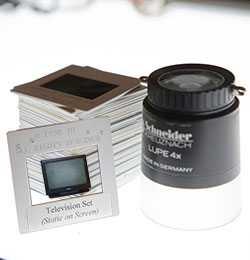 10+ years ago, pre-internet, every month, like clockwork, my agency would send out their monthly "needs list". Sometimes, It'd come with my returns, sometimes, by fax, sometimes with my sales reports, but always old school style, killing trees in the process. In it would be items listed like "goldfish in round bowl on white seamless", or "current model television large tv from different angles." These items were, simply put, requests that had been received by the agency's photo researchers, that resulted in no images being found in the library.
10+ years ago, pre-internet, every month, like clockwork, my agency would send out their monthly "needs list". Sometimes, It'd come with my returns, sometimes, by fax, sometimes with my sales reports, but always old school style, killing trees in the process. In it would be items listed like "goldfish in round bowl on white seamless", or "current model television large tv from different angles." These items were, simply put, requests that had been received by the agency's photo researchers, that resulted in no images being found in the library.
The request for the images had long since been filled by a competitor, but those who were looking out for my best interests were telling me, essentially, where the holes were in their library, and that, if I had those images, or were looking for something to shoot, I'd have a good shot at making a sale. 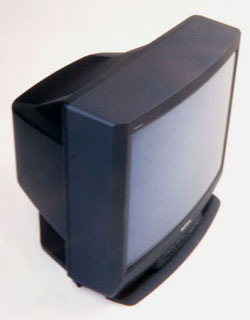 I never did shoot the goldfish, but I did go out and buy a $600 Sony 27" television, set it up in my living room on white seamless, and shot it from - left/right/looking up/looking down, and so forth. I did, of course, also shoot countless in-camera dupes, to ensure the best quality. To date, as a rights-managed image, that single shoot has generated over $10k in revenue, and the tv still works, playing all my Tivo'd shows nowadays.
I never did shoot the goldfish, but I did go out and buy a $600 Sony 27" television, set it up in my living room on white seamless, and shot it from - left/right/looking up/looking down, and so forth. I did, of course, also shoot countless in-camera dupes, to ensure the best quality. To date, as a rights-managed image, that single shoot has generated over $10k in revenue, and the tv still works, playing all my Tivo'd shows nowadays.
How then, do we help photo researchers and photo buyers locate us, and our archives?
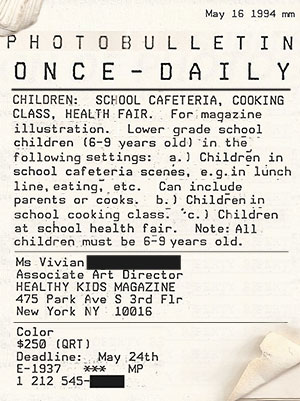 Back in 1994, in tandem with my agency relationship, I was a subscriber to Rohn Engh's Photo Bulletin. He had several flavors, daily, weekly, and bi-weekly. Every day I recieved a fax from Rohn (note I pulled one from my archives, at right), with requests he had received from photo buyers, researchers, and agencies, looking for specific images. The photo buyer would list the specifics of the need: the usage (brochure, magazine illustration, etc) their deadline, and what fee range they would pay for that. Rohn's of course evolved with the times, with his PhotoDaily .
Back in 1994, in tandem with my agency relationship, I was a subscriber to Rohn Engh's Photo Bulletin. He had several flavors, daily, weekly, and bi-weekly. Every day I recieved a fax from Rohn (note I pulled one from my archives, at right), with requests he had received from photo buyers, researchers, and agencies, looking for specific images. The photo buyer would list the specifics of the need: the usage (brochure, magazine illustration, etc) their deadline, and what fee range they would pay for that. Rohn's of course evolved with the times, with his PhotoDaily .So too, has Digital Railroad. Enter the ResearchNetwork. Getty recognizes that once you're at their site, you're a probable buyer, and they want to keep you there. So, if your search results yield zero, or what you did find wasn't satisfactory, (see my example of a search for the White House on Getty and iStockphoto, by clicking here) they want you to call on the phone. How antiquated.
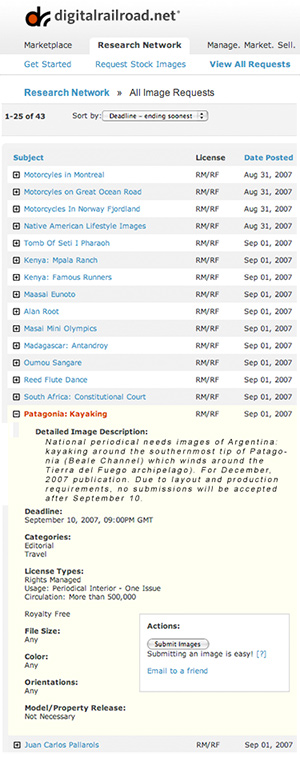 By Visiting gettyimages.com/Search, you read:
By Visiting gettyimages.com/Search, you read:"Can't find what you're looking for? Call us for free research assistance. We'll not only help you find the right image, we'll give you 15% off once we've found it...Just mention the "zero-results promo" to the researcher who helps you. " Getty too would like to know where the gaps are in their library. And while aggregating all the "zero results" searches, instead, why not automate the process?
There are a number of ways I can see this evolving.
For instance, with automation, a photo researcher could place a ResearchNetwork inquiry in the evening, and have images "pushed" to them the next morning. Thus, the photo researcher/art buyer could simply post a list of their needs to the DR membership, and not have to bother with their own searches in the first place, if they wanted to. Of course, they could also actually perform the searches as well, it's there perogative. I noticed under the column "License", it lists both Rights Managed (RM) and Royalty Free (RF). When asked about the designation "RM/RF", for the requests, Digital Railroad President Charles Mauzy said that "In the case of the requests displayed at launch, all the participating buyers were willing to look at both RM and RF, which is why we see the stock research requests displayed showing both licensing models. If a buyer only wanted RM you would only see "Rights Managed" listed along with the specific use details. Royalty Free would not appear. "
Back in the days of analog, stock needs sheets went out to all the agencies from editorial clients to book publishers, and so forth, with blanket permission to bill the publications' overnight account #, and the next day, slides would pour in. Instead, those same needs sheets could be posted for and sent via RSS feeds to DR members, and they could push their results to the interested parties. In essence, the researchers/buyers are able to get more done, and the results are better because photographers know what they have in their libraries, whether digital, or analog, regardless of caption accuracy, or the extensive nature of the keywording.
For example, the first idea that popped into my mind was "pickled tomatoes" (with the quotation marks). Trying that search on Getty at http://www.gettyimages.com/Search/" (with the quotation marks) yields:
"pickled tomatoes" (0 images found)Removing the quotation marks and you get pickled vegetables, Getty's site further understands that "tomato" is the singular of the word "tomatoes", and finds the singular version in the keywords, then an image with a pickle and a tomato in a refrigerator, several images of pickled tomato jars, then image #71086890 has in the caption field "No caption available", and several other images of sun-dried tomatoes with no pickled anything appearing in the image, but the word "pickled" appears in the keywording area, 19 images in all, none suitable.
Next up - Corbis. Searching Corbis for "pickled tomatoes" yields this result - a single image of pasta with pickled tomatoes, but the tomatoes aren't really even visible.
Search on Google for "pickled tomatoes" yields "about 500 images", several of which are source-able from istockphoto and dkimages, but those are just the green tomatoes, which might work, but suppose you want an image where they're prominent in a food dish? Suppose you have search fatigue? Photographer Allison Dinner has a nice image that was returned in the Google results, and it appears in Washingtonian Magazine's archives from September of 2006.
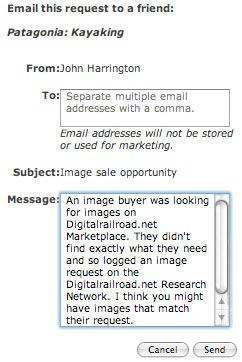 Whenever I talk to friends and colleagues about Digital Railroad and Photoshelter, inevitably the first question people ask is if I am making money, and the short answer is yes, from both of them. However, if your monthly fees entitled you to a qualified list of specific images from buyers on a regular basis, I think this would be a great way to increase the probability of income. Although, now, when you know your friend is an avid kayaker (for example), and they have images of kayaking in patagonia, on the graphic above, where there's the button "Submit Images", there's also a link "email to a friend", which brings up the window to the left.
Whenever I talk to friends and colleagues about Digital Railroad and Photoshelter, inevitably the first question people ask is if I am making money, and the short answer is yes, from both of them. However, if your monthly fees entitled you to a qualified list of specific images from buyers on a regular basis, I think this would be a great way to increase the probability of income. Although, now, when you know your friend is an avid kayaker (for example), and they have images of kayaking in patagonia, on the graphic above, where there's the button "Submit Images", there's also a link "email to a friend", which brings up the window to the left.In addition, I can remember almost all of the images I've shot, and I know I've not shot pickled tomatoes (or kayakers in Patagonia for that matter). However, being able to tap into my own memory of what I did (and did not) shoot increases my mental keywording that I have in place for those images, and moreover, allows me to say "yes, I did shoot verticals of XYZ widget in color (colour!) and I know where they are."
I have countless images in my analog archive, that have not been scanned yet. I've got my own internal priority list, and am about 10,000 images through it, but at any given time, within a day, I can have a (small) collection scanned, captioned, and online, if I only knew which could garner an immediate sale. In addition, I have a number of images that were shot digitally, but, for whatever reason (usually not enough time), I've not uploaded them. If I could be alerted to what's needed, and what it was worth to me to find the time, I'd be motivated to upload.
Unlike the PhotoBulletin, The DR process is automated. Photo researchers - whether obtaining results that "aren't quite right", or give the ubiquitous "no search results found", can submit their request via DR, who then passes it along to it's members. Members can search their own archives for images that meet the buyer's need, (if analog, then scan and apply proper metadata), upload, and send a lightbox of images off for that buyer to review. DR handles all the negotiations over the images' license - fees, terms, and so forth, and collects their 20% fee, while the photographer takes home their 80%.
If you're a photographer who hasn't ever keyworded an image, you're loosing sales, I can almost guarantee that. Perhaps you did, but are missing keywords, or did them wrong. Perhaps the researchers weren't familiar with the nuances of basket-making by hand, or the various styles of Native American dancing, and also were either doing the research a bit wrong, or just didn't want to do it, and wanted to aggregate the power of independent photographers who did know what they shot, and the nuances of such, all stuck in their memories of the assignment.
What does the future for this hold? Getty's site suggests "Still can't find the perfect picture? Commission a Getty Images photographer to fulfill your specific imagery needs." Not a bad idea. If you don't have the images at all, and the buyer's not getting the lightboxes that meet their needs from any Digital Railroad members (or other agencies for that matter), are you then able to solicit an assignment commitment from the client, with fees (and expenses) paid for work performed and license specifics detailed? Would the client take into consideration your capabilities based upon your website/portfolio, and then commission the work to be completed by you alone, or would DR evolve into a semi-OnRequest model? I think that if the former concept was a future-concept for DRR, it could be very workable. If, however, the latter was rattling around in any of the minds of the DR leadership, sadly I have to say, take a hint from Davis Norris, (OnRequest - Realizing the Obvious, 7/12/07), who finally said of his own OnRequest model "that model was interesting, but didn't pan out." It's not like Norris is a bastion of genius because of his ability to forecast good business models, but rather, he stands as the poster child for how not to run a photographically-based business, such is the basis for the hint his actions offer.
Let's see what populates the list. So far, among the requests are: Motorcycles for a magazine; Native American portraits for marketing materials; images from Tombs in Egypt, to Kenya, Madagascar, Brazil, China, Jaipur, Tibet, and Italy; and images of Fathers/Mothers Day; and various types of people using wireless devices. The wireless one in particular, is an advertising request with a circulation/press run of over 500k, so that could generate some significant revenue. Wouldn't it be interesting if some of the iStock-ers got access to the list, and instead of $0.20 per image, were being paid $150+ per image? That might be a wake-up call for them. Maybe they'd invest in a membership to DRR, if for no other reason than to get at a list of images that they probably already have, and are hawking for pennies, not realizing the value they potentially have. I know of many a photographer who's joined ASMP and APA for no other reason than to get on their Find-a-Photographer list, because they've heard it pays for itself every year. Further, since the actual buyers' names are protected, and the negotiations are handled by the DR sales staff, the photographers can't screw themselves by undervaluing their assets, and diminishing the market.
This model holds great promise, and has great potential. I'll watch closely to see what (and how) it delivers.
Note: Some of the graphics above have been repaginated to fit into the contraints of the blog.
Please post your comments by clicking the link below. If you've got questions, please pose them in our Photo Business Forum Flickr Group Discussion Threads.

7 comments:
John,
Thanks for this informative post. I've been considering joining DRR lately, especially when they announced their deal with ASMP that will give me a discount, and even more so with this interesting advancement. I'm very interested to see how this concept works in practice so please keep us updated. If nothing else I suppose it could be a steady stream of stock shoot inspiration.
The comment about istock-ers using a list like this really pricks my imagination. I'd like to hear more of your thoughts/predictions on the effects this could have in that realm of our profession.
Thanks for taking the time to give this a good thoughtful post.
i really like that this post gives useful information on what you think us istockers could be doing, instead of ranting over and over again about how much you don't like us. that way it's much more likely that you'll change something!
Christopher -
It's not that I have a personal issue with istockers, (but it could well appear that way), but rather, what istockers ACTIONS are doing to the profession. I would like nothing more than to have those producing work for istock and earning $0.20 per image to realize the true value of the work you are producing, and begin to earn what your work really could be generating, as noted in the article, upwards of $150 per image.
Now this is the kind of information I come to your site for! Thank you for a great and informative post.
John,
Thanks for this information. We have been looking for more services to help us expand our RM images and DRR seems like a good fit. Always like your informative posts.
Thanks for the great information! I go to AGPix and Photographer's Direct for those hard-to-find photos. It's good to know of another place where I can post requests.
You also touched on another important point - that often those stock photos will continue to generate revenue long after the first sale.
Very interesting article; giving people knowledge instead of just a tongue lashing when people try to sell stock images on-line. Hope to read more on this subject.
Dan
Post a Comment